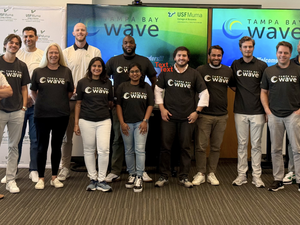
Clyde Snodgrass doesn’t think that the Vino Novo is something to whine about.
Snodgrass is the founder and CEO of Faraday, Inc., the startup behind the Vino Novo, a device that produces an electric field inside a bottle of wine to simulate aging of the wine. The field deconstructs the wine’s components to induce an electrochemical reaction that ultimately augments the flavor. The product officially launched at the Synapse Summit, Jan. 23-24 at Amalie Arena in Tampa, and is slated to hit the market this May.
Snodgrass was inspired by his uncle and his Italian heritage to create the Vino Novo.
“We’re first-, second-, third-generation Italians, and my uncle used to get grapes sent over from my family’s villa in Italy and he would make wine,” Snodgrass said. “And in 2008, I got the idea from a paper about electric fields, and how electric fields are used for wine maturation and food preservation.”
In 2015, Snodgrass built a prototype, with the encouragement of his former wife, Nicole. Around that time, she held two jobs so that the couple would not have to spend their savings in order to make his dream a reality.
“It was a labor of love of sorts, but in reality it was exhausting for both of us – physically and mentally. … [I] [d]idn’t realize how much she had sacrificed until two years later and for that, I’m eternally in her debt,” Snodgrass said. “If it weren’t for her, I wouldn’t be where I am now---about to launch one of the coolest products anyone has seen.”
According to Snodgrass, three kinds of consumers appreciate the Vino Novo: early adopters, everyday loyalists and image seekers.
Early adopters are, for example, consumers who camp outside of an Apple store days in advance of an iPhone launch. Everyday loyalists “drink to drink,” Snodgrass said. Image seekers are those who drive flashy cars, he said.
Those three kinds of consumers have all completed at least some college education; drink three or more bottles of wine a week; and make at least $50,000 a year.
“Realistically, this is meant for anybody who drinks wine, but doesn’t want to spend $40 on a bottle,” Snodgrass said.
The Vino Novo will initially sell for $149-$179, then for less than $100 after 12 months “of refining the design and getting production costs down,” he said.
Vino Novo is currently debt-free, and in a seed round in which it hopes to raise around $600,000. Vino Novo’s competitors are Coravin, a wine preservation system-manufacturer that has raised $64 million in venture capital over the past three years. Its other competitor is Plum, an automatic wine dispenser-manufacturer that has raised $23 million in venture capital.
His long-term plan is to license or sell the Vino Novo to a small appliance manufacturer, such as KitchenAid or Keurig. In the meantime, Snodgrass plans to sell the Vino Novo both online and at big-box and brand-name stores.
With expectations high, Faraday’s founder looks to build on the momentum that the Vino Novo gained at the Synapse Summit, where it was exceptionally well-received by wine drinkers. Of the many wine enthusiasts who have tasted wine treated by the device since it was created, “literally under five people…have ever said that it doesn’t taste better treated,” said Snodgrass.









